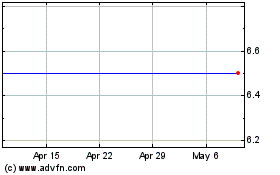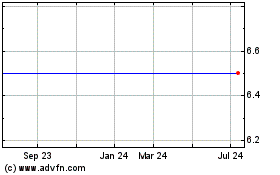By Heather Haddon
Smart & Final Inc. has made some changes lately that would
seem like near-heresy for a supermarket: The California-based chain
ripped out racks of snacks and other profitable impulse purchases
near the doors of some stores and instead installed freezers
there.
But grocery executives say the seemingly irrational move is
simply one of many signs that the supermarket business is radically
changing. The freezers will serve as pickup points for customers
who order their groceries online and may never go any farther into
the store.
Such online sales, says Smart and Final Chief Executive David
Hirz, is "becoming a meaningful piece of our business."
After years of inertia, U.S. supermarket chains are racing to
add online options, such as home delivery and in-store and curbside
pickup, to keep shoppers from shifting more of the $800 billion in
annual food and beverage spending to e-commerce firms such as
Amazon.com Inc. The process is spurring retailers and major food
brands to change fundamental aspects of their operations -- from
staffing and supply networks to the way they organize their parking
lots and stores. At the same time, the online shift has created
complications for the physical stores.
Bill Bishop, co-founder of consulting firm Brick Meets Click,
calls it the biggest change to supermarket operations since the
introduction of bar codes to consumers goods. "There really hasn't
been anything this sweeping operationally since," Mr. Bishop
says.
Expected growth
E-commerce represents less than 5% of U.S. grocery sales
currently, but food and beverage sales are growing far faster
online than in traditional supermarkets. Forrester Analytics
predicts that by 2022, the U.S. online grocery market will total
$36.5 billion, up from an estimated $26.7 billion this year.
Walmart Inc.'s purchase of e-commerce site Jet.com in 2016 and
Amazon's acquisition of Whole Foods last year have pushed grocers
to accelerate their online expansions.
Looking not to be left behind, grocers are remodeling their
stores and designing new locations to better accommodate online
ordering. Smart & Final plans to make the front of some of its
new stores wider to allow for more racks and refrigerators, Mr.
Hirz says. Many supermarkets are reserving parking spaces where
customers and delivery services can quickly pick up online orders
bagged at stores. Some stores have designated checkout lines to
ring up larger orders from third-party online grocery-delivery
services such as Instacart, while others have created separate
entrances for delivery pickups.
Food makers, meanwhile, are beefing up e-commerce units to make
sure customers can find their goods online, and to track their flow
from retailers to customers' homes. "We have to all be careful to
think this through," says John Carroll, general manager of
e-commerce for Coca-Cola Co., which has 50 employees working in its
online division.
The beverage and snack company now replenishes stocks at some
stores around the clock, Mr. Carroll says, after finding that
nearly 50% of online orders are placed at night and retailers tend
to package pickup orders during off hours. It also has changed some
of its packaging to make it lighter and less prone to damage for
its online sales.
Food retailers such as Walmart and Kroger Co. are spending tens
of millions of dollars to acquire digital-ordering technologies,
implement home-delivery systems and build thousands of store pickup
points for online orders. Kroger, the U.S.'s largest supermarket
chain, has hired or assigned nearly 19,000 workers to run an
estimated 1,400 pickup sites for online orders, covering roughly
half of the company's stores. It is expanding same-day delivery
through Instacart to 75 additional markets this fall, and launched
its own mail-order service for shelf-stable goods this summer.
Target Corp. is introducing a new inventory system to replenish its
stores and fill online orders faster as part of a $7 billion
overhaul.
Retailers also are adding online more of the bulk items that
e-commerce shoppers prefer. Larger packages of cookies and other
foods tend to be more economic to ship online, helping to offset
delivery costs, says Carmela Cugini, vice president of operations
and curation at Jet.com.
Snack brands, meanwhile, are trying to figure out how to boost
impulse purchases when customers increasingly aren't walking by
their items at checkout. Hershey Co. pays for promotions and better
retailer-search results to encourage online shoppers to add its
candies and snacks to their online baskets, and uses its data to
tailor those promotions based on past purchases, says Doug Straton,
the company's chief digital commerce officer. "You cannot think
about impulse purchases the same way as in the physical world,"
says Mr. Straton.
Many customers have come to love services they say save them
time and hassle.
"I don't physically shop in grocery stores anymore unless it is
out of absolute necessity," says Shelby Allen, a 23-year-old
health-care worker from Hunt County, Texas, who uses Walmart's
grocery pickup service for most of her supermarket shopping. "It
has simplified my life so much."
The online push, however, poses risks for grocers, as it
requires upfront investment and can detract from the in-store
experience for customers who still generate most of grocers' sales.
Because most U.S. grocers fulfill online orders from physical
stores, rather than warehouses like Amazon, keeping goods in stock
can be tricky, given different ordering patterns and limited
backroom space.
Grocers tend to fulfill online orders from their back
inventories, but third-party delivery services such as Instacart
send couriers into stores to grab products off store shelves.
Clerks fulfilling online orders can clog aisles and checkout lanes
or pick over the best produce, customers and grocery consultants
say.
"The last thing I need while getting groceries is more
frustration," says Kristyn Booth, a 48-year-old teacher from
Austin, Texas, who resents the lines that online grocery pickers
create at the stores where she shops.
Trained pickers
Instacart says it is trying to lighten its impact on stores by
running tight staging areas in supermarket backrooms, batching
orders and using dedicated checkout lanes. The company, which
contracts with 50,000 shoppers, says it does train pickers to
select the best produce, though that varies by personal
preferences.
Kroger is trying to combat congestion in its aisles by having
clerks picking produce for online orders wear portable scales to
speed up the process, says Matt Thompson, vice president of
digital.
Grocers and food makers also are scrutinizing their supply
systems to keep from running out of stock as e-commerce orders
swell. The Grocery Manufacturers Association was stunned to
discover in August that online grocery out-of-stock rates hover at
15%, nearly double in-store averages. When customers don't
immediately find the items they want, 70% switch to another brand
or store, or stop their order, the trade association found.
Kroger has fined suppliers who don't deliver on time and in
full, and Walmart has given more business to those consistently
delivering on time. Smart & Final is getting more frequent
delivery of goods, executives say.
Walmart also is working on integrating its supply chain with its
Jet.com division. It aims to get more goods to customers more
quickly by using algorithms to determine which fulfillment centers
can best fulfill a customer's order, says Ms. Cugini.
In the future, grocers may need to build separate warehouses for
fulfilling online orders, given the pressure the business creates
on their existing supermarkets, says Nick Hernandez, managing
director of retail services at real-estate services firm
Transwestern. Retail locations can shrink, while the warehouses
could be rented for a fraction of the cost of a storefront
supermarket, he says.
Through it all, grocers are struggling to find a balance between
encouraging customers to place orders online and drawing customers
into their stores.
"The stores have to improve," says Mr. Bishop, who advises
supermarkets on how to build online operations. "We haven't found
the secret sauce to get shoppers to routinely go to the store."
Ms. Haddon is a reporter for The Wall Street Journal in Chicago.
Email her at heather.haddon@wsj.com.
(END) Dow Jones Newswires
October 02, 2018 22:21 ET (02:21 GMT)
Copyright (c) 2018 Dow Jones & Company, Inc.
SMART & FINAL STORES, INC. (NYSE:SFS)
Historical Stock Chart
From Mar 2024 to Apr 2024

SMART & FINAL STORES, INC. (NYSE:SFS)
Historical Stock Chart
From Apr 2023 to Apr 2024
